ELEVEN YEARS LATER
‘Witnessing the shooting of people at Marikana left a massive scar’ — Felix Dlangamandla re-examines his images from that bloody day
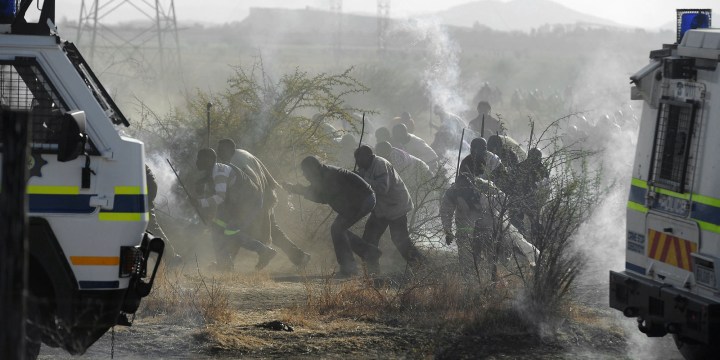
In this republished account from 2021, Daily Maverick Photo Editor Felix Dlangamandla discusses his harrowing, life-changing coverage of the Marikana massacre on that bloody day of 16 August, 2012. Together with journalist Lucas Ledwaba, Dlangamandla reexamines the images he captured that shook the world and cast a deathly shadow on South African democracy and law enforcement.
Photojournalist Felix Dlangamandla was in the line of fire as police shot and killed 34 mineworkers at Marikana on 16 August 2012. In this in-depth interview with Mukurukuru Media editor Styles Lucas Ledwaba, he reflects on some of the defining photographs from South Africa’s first post-Apartheid massacre.
Styles Lucas Ledwaba: Thank you Mhlekazi for your time. For the benefit of those who may not know we were [working] together during the Marikana strike. You shot thousands of photographs during the strike at Marikana in 2012. But we have asked you to select five images for this discussion, to try and provide better understanding and to also look back on that difficult period. So in the first photograph, you have a huge crowd of people gathered and some are carrying flags and some are carrying sticks and one appears to be carrying a panga. What is the story behind this photograph?
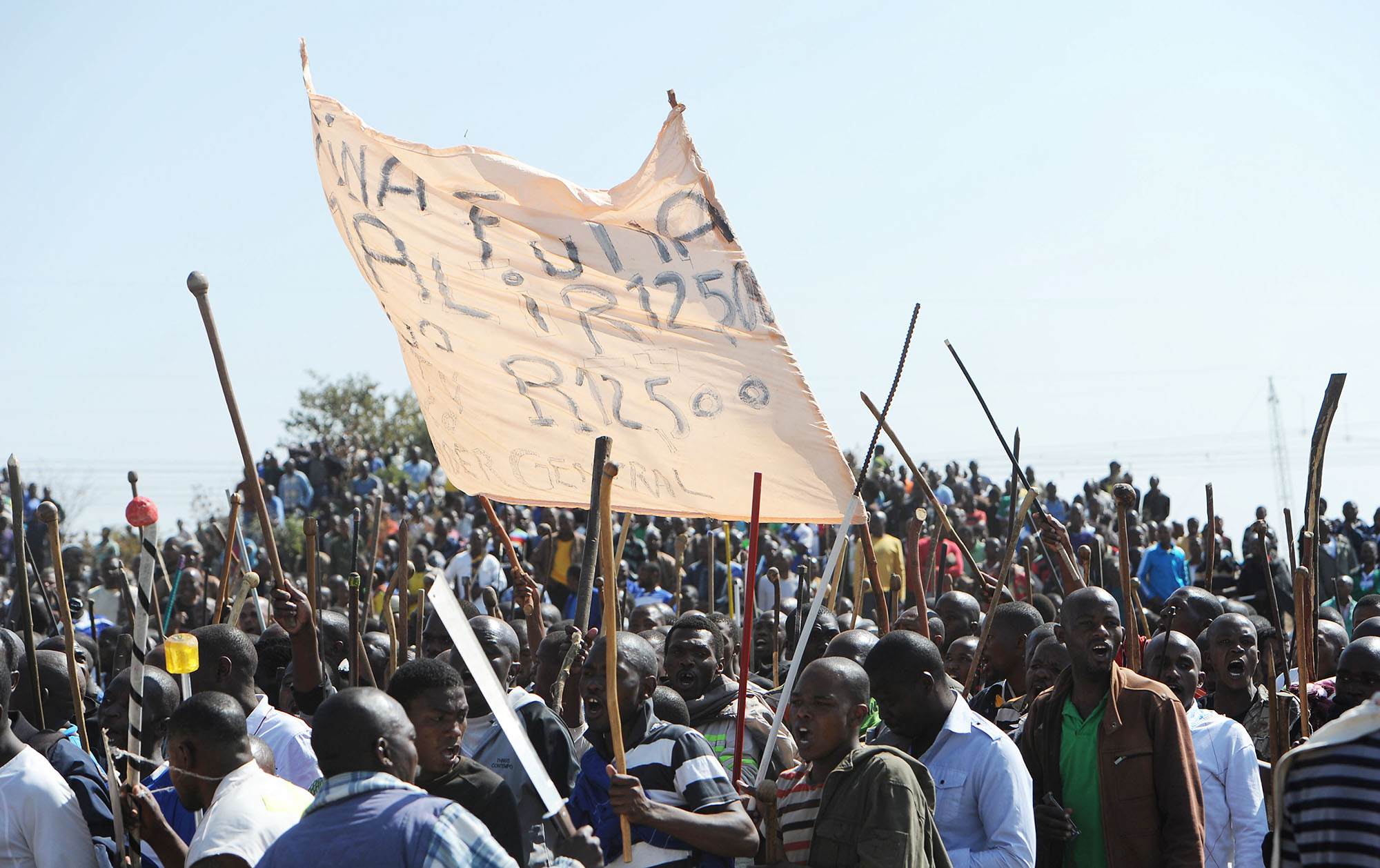
Mine workers carry dangerous weapons as they gather at the Nkageng informal settlement on August 16, 2012 in North West, South Africa. At least 10 people have died since the workers embarked on an illegal strike at Lonmins Marikana Platinum Mine. (Photo: Gallo Images / Foto24 / Felix Dlangamandla)
Felix Dlangamandla: Culturally, it is normal that men carry around knobkerries. This particular one is very different in such a way that the men here, the way they [are] carrying these sticks and pangas showing the anger abanayo, they [were] portraying a level of sadness at the bad treatment that they’ve been getting. And without anyone listening to them. So that is in a way. It just showed that these guys were out there gathering, carrying these sticks and pangas saying look, we are not being listened to. Hence the flag that says ‘sifuna iR12 500’. So to me, it was just a message that they wanted to put across over to whoever was watching.
Styles: When you took the photograph, this was probably on the Tuesday, the 14th of August or Wednesday? What do you remember about that particular moment when you took the photograph?
Felix: It was the 16th [Thursday]. There’s a few things that I can still remember [from] that day. In my own view, people were not angry that morning but they were just demanding what I would call or say was due to them. And the police monitored each and every little thing that was happening. Roads were blocked into the northern main entrances into Marikana. I used a little dirt road after I called one of the guys [striking workers] [for directions]. So tensions were starting to get high about 11-ish or so cause at some point there was back and forth with the police and the miners were not backing off. Well, [Joseph] Mathunjwa came to address them. He just asked them to be careful [saying] ‘look, they’re planning to disperse you one way or the other.’ They will be dispersed [from] that koppie. But they should be careful. I remember him going down on his knee…what I can still remember that Thursday is that a group of women also came wanting to be part of that strike. And then I received a call from Mambush [one of the leaders of the strike]. I remember him saying ‘buza abafazi bafuna ntoni apha?’ And then I went to them, at some point after they’ve been picketing and stuff like that not far from the main koppie and then I went. I got another call from Mambush and he asked me to give one lady the phone. So they spoke with one of the ladies, they exchanged whatever they were exchanging and the lady called the rest of the group and then they left. And [as] we were hanging around there taking all those pictures, negotiations were happening. And then at some point, I think police decided that now we need to end this. I don’t know how but I think it was around about three or two thirty. I received another call from Mambush. And he said to me, look, man, give me two journalists, I need to speak to them and tell them that look, we’re not agreeing with the police wherever negotiations are taking place are not working for either [of the] parties.
Styles: Let’s hold it there. Thank you very much. I think that’s a very, very detailed account because the picture when you look at a photograph, usually although it’s a still, a film sort of unfolds and it takes you back to events around the picture. And I think maybe that is one of the important elements of photography and capturing memories. There’s a picture that you also selected of the workers moving next to the police Nyala with electrical power lines behind them and so on. And Mambush is in the front there. Tell us about that picture. It is a very powerful and haunting picture.
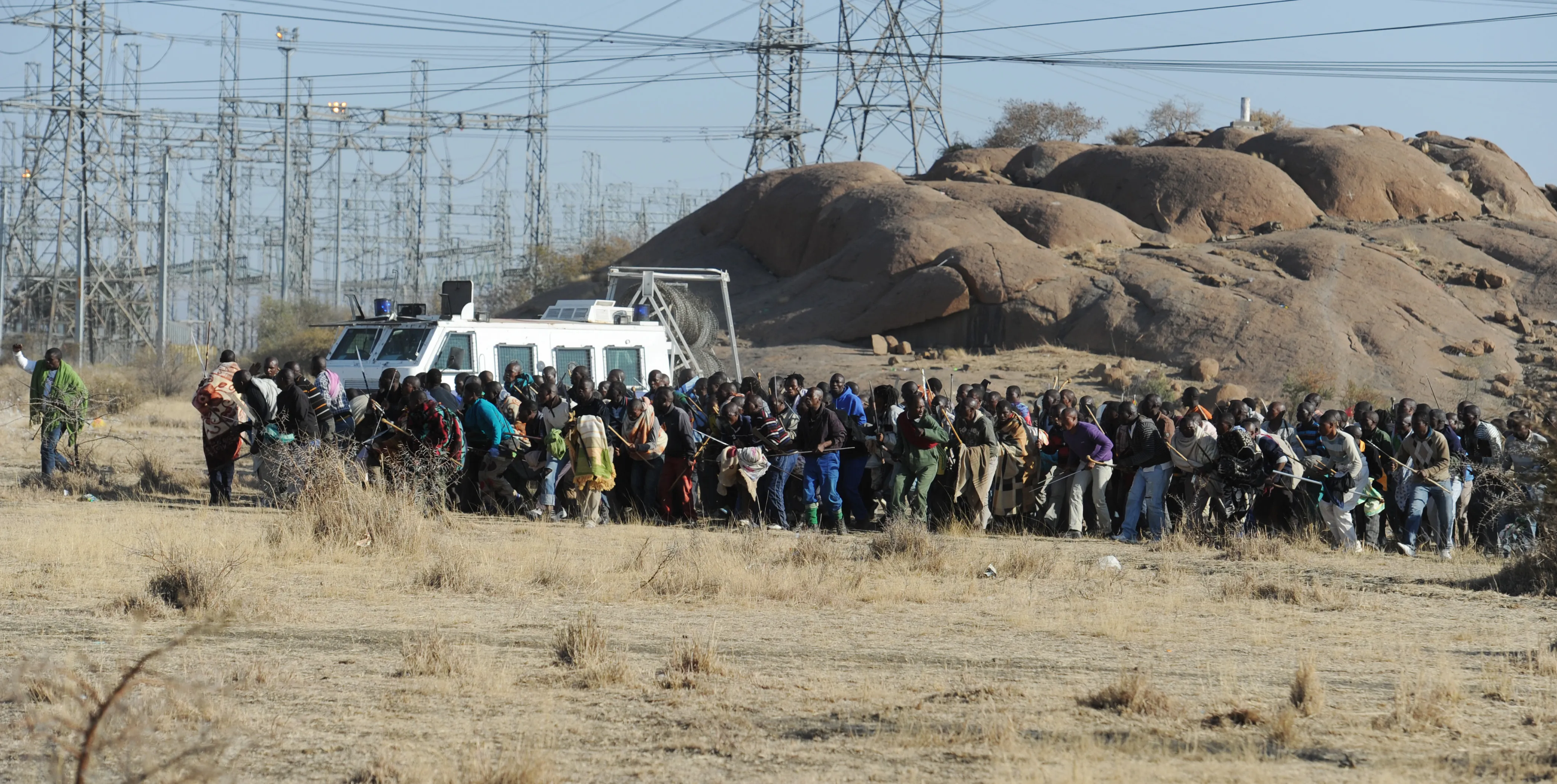
Miners walking alongside an nyala that was pulling barbed wire, seconds before the shooting took place outside Nkaneng informal settlement near the Lonmin mine in Rustenburg, North West, on 16 August 2012. (Photo: Felix Dlangamandla)
Felix: Yeah, most of the people behind [Mambush] in that picture died, some got injured severely. This was like actually 10 minutes after taking that picture or even less than that. Yeah. And then some of them died. So basically we decided [with other photographers] that we’re tired of taking pictures normally when we cover service delivery protests shooting behind the police getting long shots, let’s be part of this group so that if police shoot we get the facial expressions, so some of the photographers and we went with that crew but something told us that guys no man, just stay away. Move away from these guys. I think that’s when we started to move away, [that was] myself, Leon [Sadiki], Siphiwe [Sibeko] nabo Alon Skuy. We went towards a fence, there’s a fence that’s fencing someone’s shack… that’s when [police started firing] rubber bullets tear gas, and all sorts of dispersing mechanism…it was just chaos man. So that picture Styles, to me, it doesn’t haunt me, but when I look at it, and I’m trying to avoid it most of the time. I took this picture and then within minutes, some of the people are killed. So as to why I took it, yes, I had to take it because I just felt like I must, I must document everything that’s happening around. But I didn’t know then that some of the guys would be killed. But it just shows that while they were walking, crouching next to that Nyala, something could have been done to stop the shooting. Someone could have said ‘oh, let’s pick off someone’, someone could have came and said, ‘hey, let’s pick up from this. Let’s try and negotiate again’. Instead of trying to disperse the miners in the manner they did. So it saddens me [that] people had to die [for] requesting basically a better living wage. And they’re to be killed in that particular manner.
Styles: When you took this photograph, most of the people had already dispersed from the koppie in different directions. This particular group, where were they going? What was their mission? Especially at this particular moment that you took this picture?
Felix: Look, those that survived, they [were] saying they were going out of the [koppie area] they were taking a different route towards the informal settlement. So the police cordon them in and they couldn’t go anywhere. But then I mean, there were people who fled to the second koppie who got killed. So these ones were, according to them, they’re saying they were going back into the informal settlement because the group was dispersing. I mean, most of the people who are in the koppie decided to disperse in whichever direction, well I guess that’s what I can tell you. I don’t know what was going on.
Styles: [In the next photograph] you framed workers between two Nyalas crouching. There’s what appears to be teargas all over them. What do you remember about this photograph? What can you tell us about this photograph?
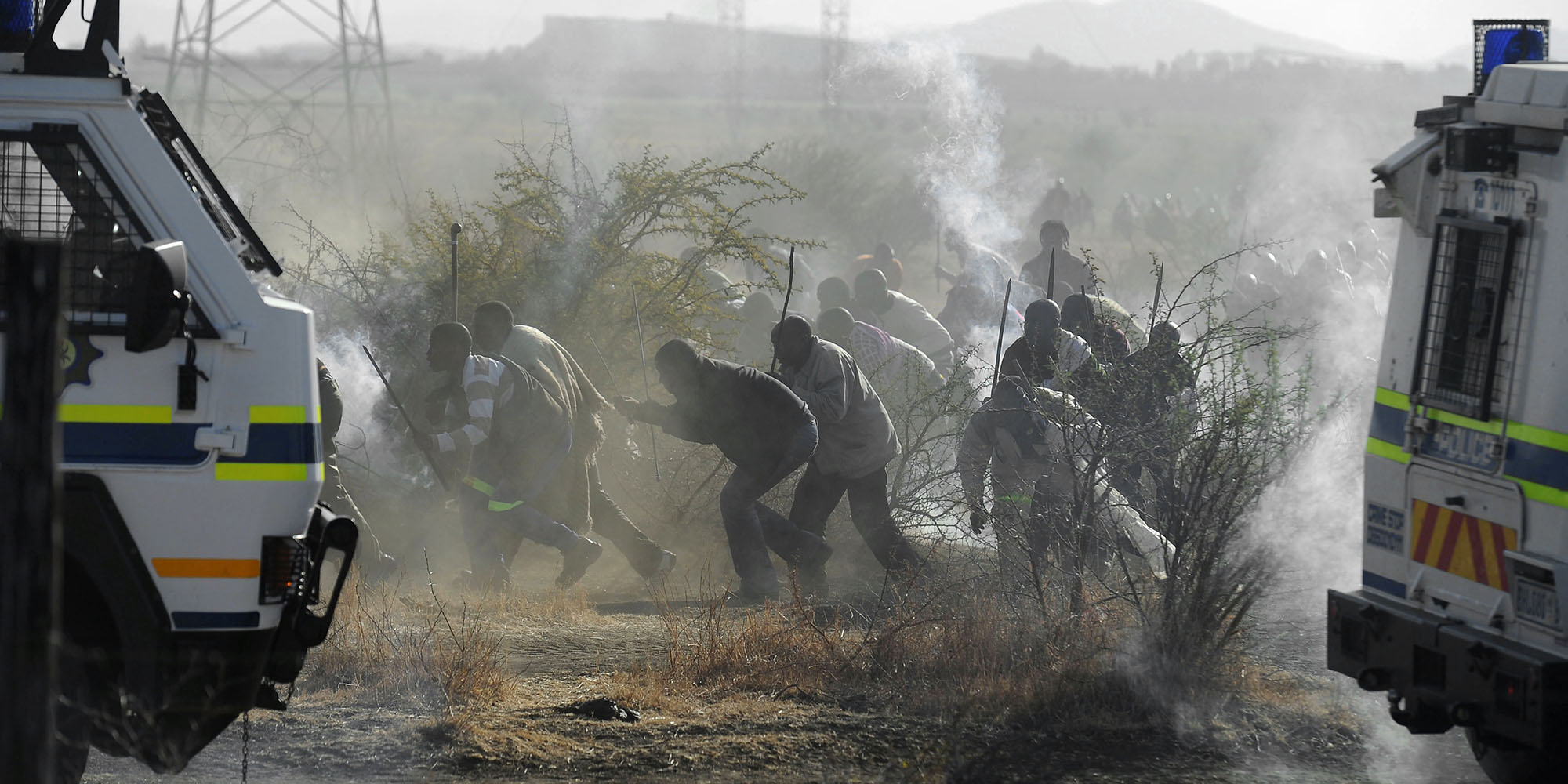
Police officers open fire on striking mine workers outside the Nkageng informal settlement on 16 August, 2012 in North West, South Africa. Violence broke out in the area as workers downed tools during an apparent wage strike at the Lonmin Marikana Platinum Mine. (Photo by Gallo Images / Foto24 / Felix Dlangamandla)
Felix: Yoh Styles! A lot was happening, the teargas was everywhere. Basically, I was struggling to breathe. And the police were just shooting at the miners who were moving forward crouching, there were water cannons spraying water all over. So, in that particular moment, that’s when I went over the fence around the shack where I was taking sort of a cover, running away from the group that we were with. So, when I turned back and looked at these guys, they were going forward, some were coming out of the kraal, jumping [out of] the kraal. So at that particular moment, what was happening, police were shooting live ammunition, rubber bullets, I mean, water cannons were spraying water. Teargas was everywhere. It was just chaos. A scary moment. In the midst of it, I didn’t know that they were firing live ammunition. In my mind, I thought it’s rubber bullets [to try and] disperse these miners because it never hit me that the police will shoot like literally live ammunition.
Styles: Okay, yeah, but how far are you? When you were taking this photograph, it does not look like you were using a long lens here?
Felix: I normally carry around two cameras, two bodies and one is long [lens], one is short. I think I was on a wide lens there. Yes. Yes. The picture is very wide. So I was, I think less than 50 metres from the people.
Styles: The people that are in the photograph at this particular time that you are shooting the picture, what are they saying? Are they singing? Are they crying? Are they swearing? What are they saying? Are they silent?
Felix: Most of them were silent. But moving forward. No one was singing at that particular time. They were silent moving forward some were gesturing, yoh! yoh! yoh! In a way, I think some were being hit by those bullets. But no one was singing, they were just hell-bent at moving forward [in] the direction of where the Nyalas were coming from.
Read more in Daily Maverick: Marikana: 10 years later
Styles: The next frame is of the gentlemen, I think it’s two gentlemen. One of them is using a shield like a spear. And as you can see behind him, there’s like so much tear gas behind him and another guy walking into the frame, and there’s a Nyala in front of him. Tell us about that picture. It’s a very, very powerful picture.
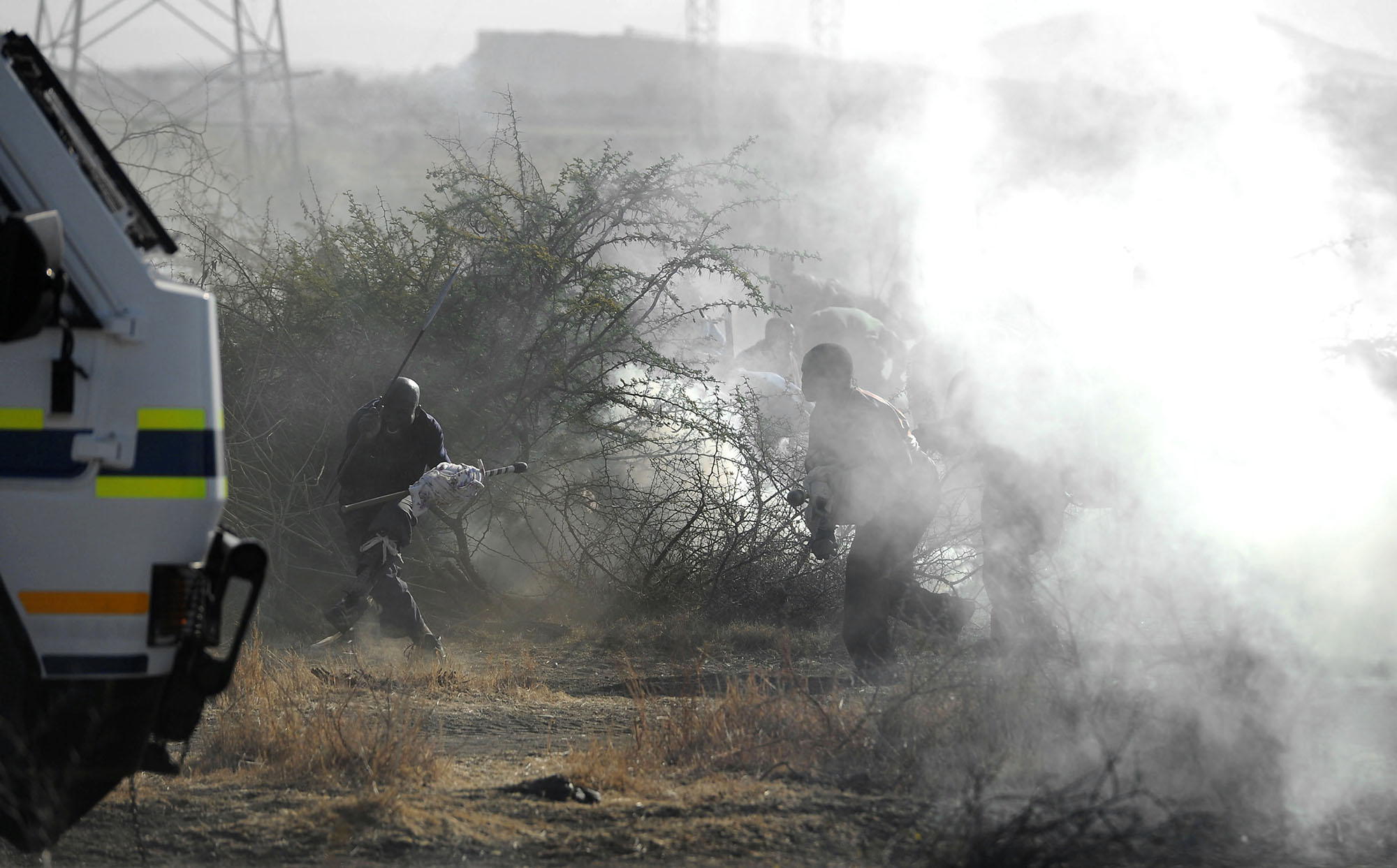
Police officers open fire on striking mine workers outside the Nkageng informal settlement on August 16, 2012 in North West, South Africa. Violence broke out in the area as workers downed tools during an apparent wage strike at the Lonmin Marikana Platinum Mine. (Photo: Gallo Images / Foto24 / Felix Dlangamandla)
Felix: Yes, this is the actual shooting but in it well, what I was observing, I was thinking that these people were being shot at with rubber bullets or something. But you can see that he’s screaming or something has just hit him. You can see the facial expression, something has just happened to him. And in the background, there’s another, there’s another gentleman trying to also move forward. Yes, he is carrying a rock and behind him some [men] are starting to flee and [are] falling. So basically, I think, if you look at other frames following this one, the guy was hit. So this is basically his facial expressions, his facial expression tells me that this is probably when he was being hit by bullets. Because in the other pictures that follow, he is one of the guys who are lying next to the kraal.
Styles: One of the 17 [it’s in fact 16] that were shot by police. I’ve seen that, yes. What does this picture say to you? What is your interpretation of the picture?
Felix: It says…[pause] I’ve been trying to interpret most of these pictures, but I don’t, I can’t come to one conclusion as to how do I interpret these images because it wasn’t supposed to happen in this manner…you can see that something has just hit him even his foot, his feet are not balanced where you can see that something has just hit him so probably these are moments before he died…
Styles: The next image is the image of people lying on the ground [and] there’s a policeman who appears to be picking up a stick, one is pointing a gun at people on the ground. The other police are pointing their guns at the people on the ground. What is the story of that picture?
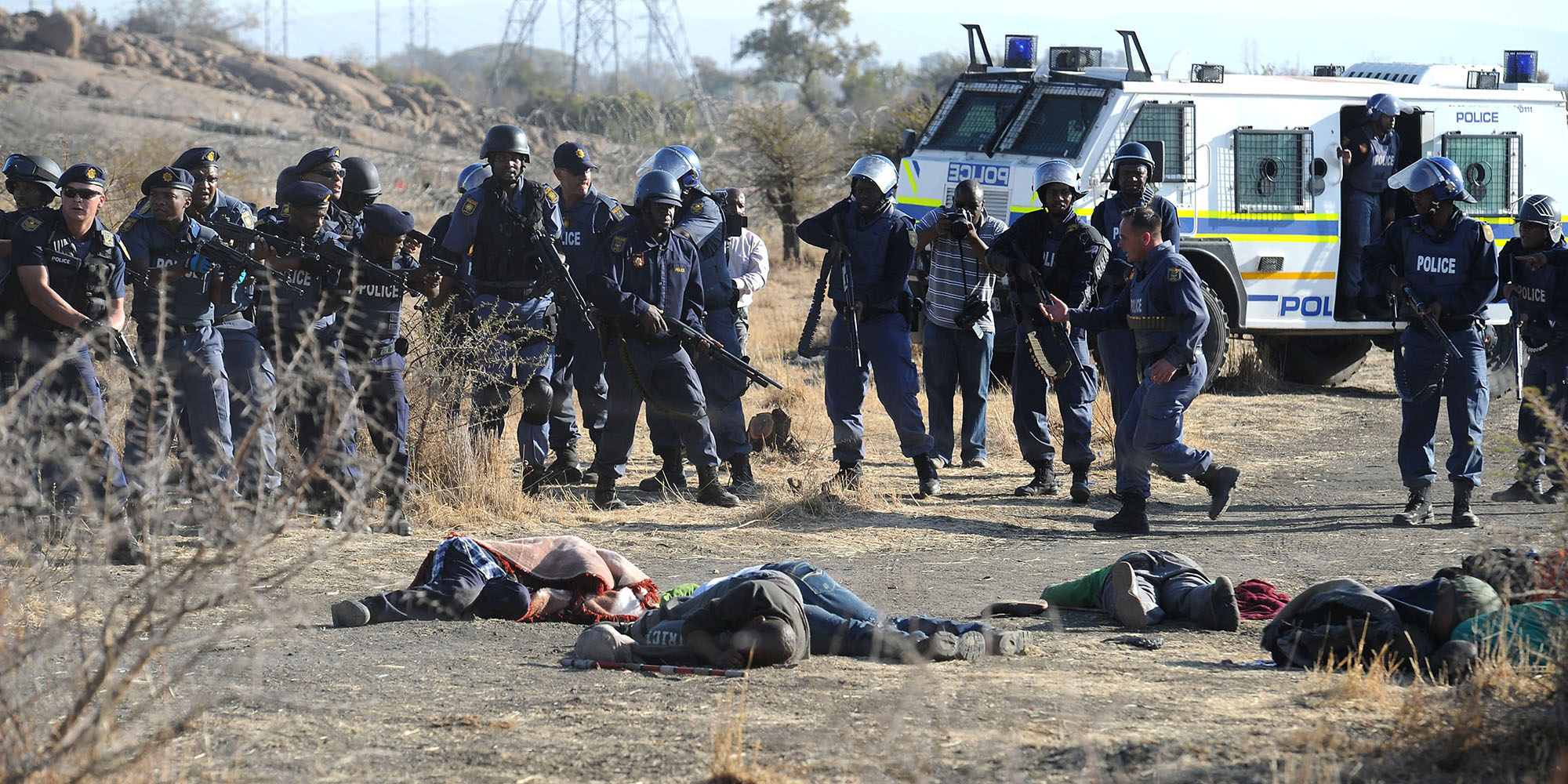
Mineworkers lie dead, dying and injured just minutes after being shot by police on 16 August, 2012. (Photo: Gallo Images / Foto24 / Felix Dlangamandla)
Felix: This is where gunfire has immediately just stopped and the police were trying to confiscate the spears and pangas that the miners were carrying. If you look at the guy in the black t-shirt lying next to a red and white stick, yes it’s the very same guy we are talking about [from previous image]…so this tells me that facial expression [from previous image], tells me that the guy was being hit by a bullet that’s where he fell, now so the police are trying to disarm all these miners.
Styles: But most of them are dead already.
Felix: Yes, yes. If not, I mean there are very few guys who survived, those who survived are two or three out of the 17 that got shot at the first scene. At that particular moment, they tried to disarm them. They’re trying to disarm people who have fallen on the ground, motionless.
Styles: The people are lying on the ground, they’re dying or they’re dead. You are there, you are taking pictures. Uhm, do you remember what emotions you are going through at that time?
Felix: No Styles, yeah look I remember what was I going through, it was just disbelief man. Look when I was taking these pictures, in my mind I’m like it’s probably injured people but you can see when you’re taking pictures, you can see that these guys [police] are not carrying rubber bullet guns. These are R-5s and what comes out of an R-5 is a real bullet. Some are carrying nine millimetres [pistols], I was like oh! What I was hearing was not rubber bullets so there’s a high possibility that some people are dead. It was also difficult to think straight at that particular moment because police were shouting at us, media move away! They were pointing these firearms at us, there was teargas, you couldn’t breathe properly so a lot has just been processed in your mind at that particular moment. But it hit me that, oh! they were not shooting rubber bullets it’s live ammunition. And then you could see that yoh! people are dead here. I mean Mambush was wearing a white, a white sweater on that particular day. There was blood oozing next to that white sweater and I was like is this the guy that I had a phone call with like an hour ago? Is he dead or is he gonna survive this thing? You know, but he didn’t survive it. So it was difficult to process at that particular moment, Styles, because I was [also] suffocating from the teargas. It was hectic man. I’ve never had so much tear gas thrown at me. So you needed to breathe in a way that you don’t sort of collapse. While you coming back some police are looking at you [and] it is happening within a split second. They are looking at you thinking, ah is he one of them? You know as in a way we are also lucky because some police would see something dangling on you. They could have shot at us as well.
Styles: What did that do to you emotionally? I mean, most of the guys were strangers in a way of we didn’t know their names, but we had seen them singing, but you had because you probably spoke the same language and they identified with you in a way you had struck up a personal relationship with Mambush and some of his comrades. Now here they are, they’re lying in a pool of blood before you but you have to do your work as a photojournalist. How do you deal with that at that moment?
Felix: Yeah, you’re right Styles. A lot of you as well, I mean, we struck up a number of personal relationships with these guys, you know, because they needed to trust us. Because we were strangers to them as well. They were doing their own thing. We went into their own territory on the Tuesday morning and asked them if can we document what was happening to show that they asking for a particular wage increase. So they needed to trust us hence we had to be personal to them in a way, striking up those friendships, but at that particular time when you see them lying there you think, what the hell has just happened?
But on the other hand, you need to deal with the job at hand now that, yes, it looks like they are dead, let me take as many pictures as possible so that if they are dead as well, this is history. But at that particular time, you’re not thinking about history, you’re just thinking, how could police kill people like this? So let me take as many pictures as possible, wherever I can get out of this before they chase us away, because they’ve got a tendency of chasing us away when they’ve made a mess. And I remember I had two memory cards with me, I had to take out the other one. So that when I’m being asked to hand over my memory card, I know I’ve got the pictures of the actual shooting with me. And the ones where people are just lying on the ground. So at that particular moment, I was emotional but not very emotional. It hit me actually when I was driving back to Joburg from Marikana. When I was processing this whole shooting in my mind, you’re driving alone, it’s dark, you’re going home and you’re listening to the radio, every [news] bulletin and all of a sudden, you get phone calls from a radio station to explain. And I asked them to be very brief because I was starting to become emotional and just thinking that these people, I was with them and all of a sudden they died. So it didn’t hit me hard at that particular time. But as I was driving alone going home, I started processing it and I just couldn’t believe it man, up to now. I still don’t believe that this happened. And I still maintain there was a way to avert this shooting.
Styles: This is nine years after the incident. Looking back do you think that us journalists who were there on that day could have done things differently? Is there something that we didn’t do right?
Felix: We were there Styles as journalists to report on what was happening. Ours was just that. Police were, they had communicators they’ve got their head people who are trained in situations like these. Police themselves as well are trained in these kinds of standards. So ours was just to be there and document and write about what was happening in front of us and I don’t believe that we need to interfere as journalists in situations like these as much as we’ve built relationships with the miners. And some police, we made personal relationships with them before the day of the shooting. But ours was to draw a line as journalists and say we’re not going to go beyond this. So ours was just to tell the world that there is a strike. miners are requesting or wanting R12,500. How do they get to that R12,500 is theirs to sort [out] but ours was just to report on this.
Styles: Witnessing the shooting of people at Marikana had a lasting impression and a very deep impact on most of us who were there on that day. What impact has 16 August 2012 had on you?
Felix: When I think of that day, I become emotional, having to see people die in that particular manner. And there was nothing I could do to try and stop them from dying. It left a massive scar. And it continues, I think it’s a wound that will never heal for the rest of my life, to see people being shot at in that fashion. And then knowing very well that there could [have] been ways of stopping it, there was a way there was a chance of coming to a round table and discussing this thing. But it left a massive scar in my life. I think three years after the shooting, attending one of those commemorations, after that, I just decided I don’t want to go to Marikana and I haven’t been there. It left a massive scar in my life that I’ll go to my grave with.
Styles: Lastly, Mhlekazi, when people talk about Marikana they seem not to appreciate the depth or the severity of what it really was. There is a photograph, the last one that we’ll discuss, of people carrying a casket up a hill. And to me this particular photograph, talks about the impact of what happened at Marikana on ordinary families, hundreds of kilometres away. Tell us about this photograph, very powerful photograph, what was happening, who was being carried. Why was the coffin being carried [like this up the hill]?
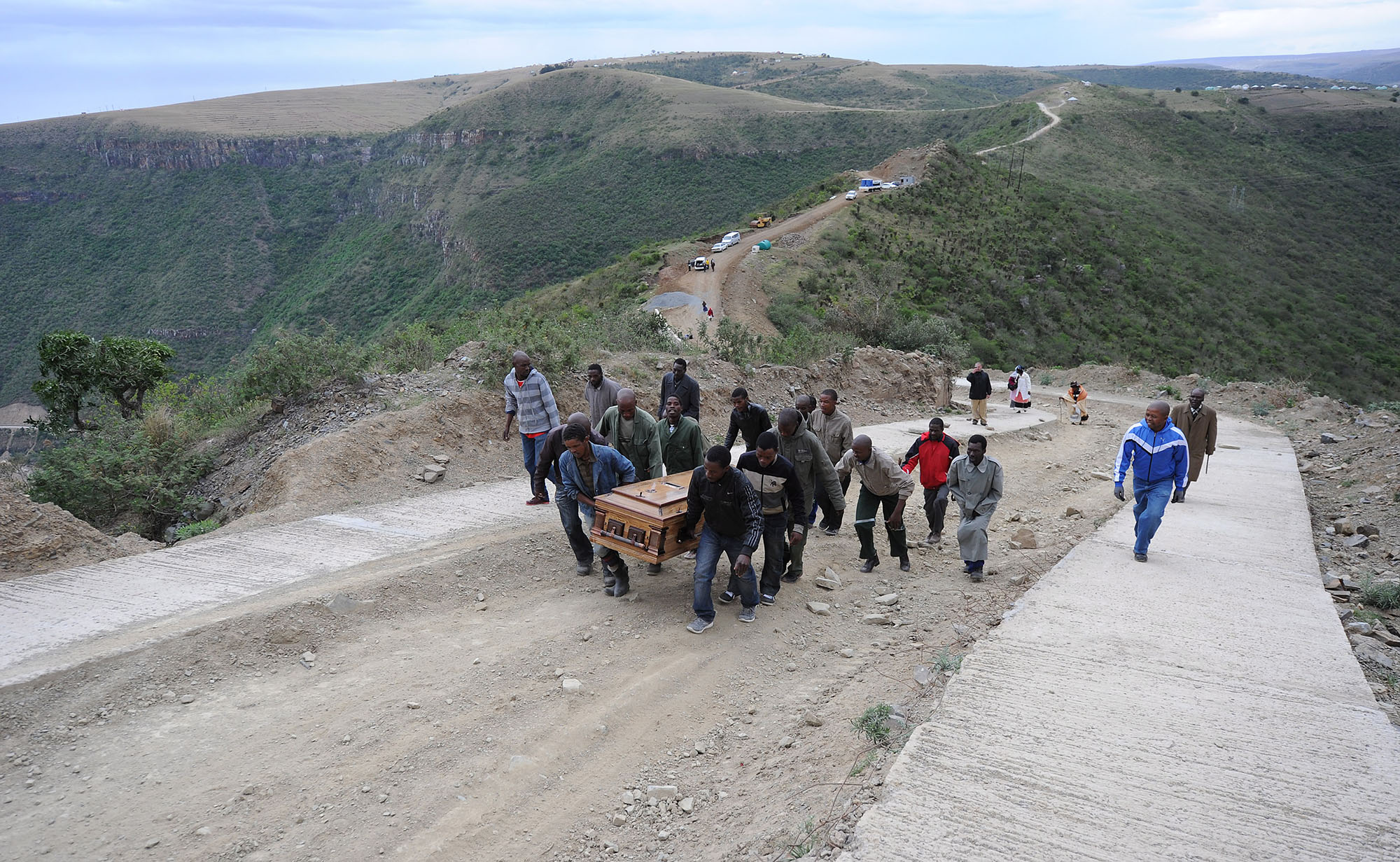
The body of Lonmin mine worker Mafolisi Mabiya is carried up a mountain to his village before his funeral on 2 September, 2012 outside Dutywa, South Africa. Mabiya was killed during violent clashes with the police following an illegal strike at the Marikana Platinum Mine. (Photo: Gallo Images / Foto24 / Felix Dlangamandla)
Felix: The impact was felt, from Lesotho to far-flung villages of North West, Eastern Cape, by the families of the people who died in Marikana. Some of these guys were breadwinners. If you look at that photograph, people are carrying that coffin up that hill, we call it a hill, it’s [actually] a mountain because cars couldn’t travel up there to this guy’s house. It shows the level, the level, not necessarily poverty, but that this guy went to Marikana to try and better his living [standard]. He had kids, he had a wife at home that he left behind. When he has to be buried he doesn’t get a proper dignified burial because of the roads that are poor. People had to put down his coffin, take turns [to carry it] because his body is heavy, walk up three kilometres to his house. For one thing that they were fighting for, which is a better living wage. They were not fighting actually, but they gathered down to say look, we need a better living wage. Please assist us and those cries fell into deaf ears. DM/Mukurukuru Media
First published by Mukurukuru Media 0n 14 August, 2021.








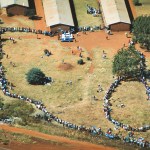











 Become an Insider
Become an Insider
Comments - Please login in order to comment.